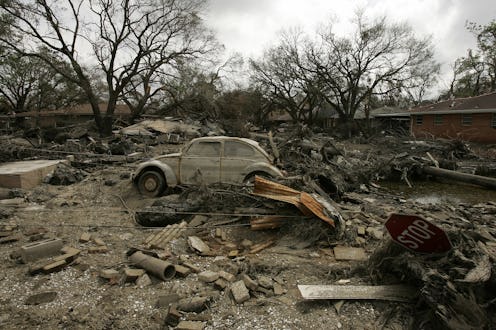News
Hurricane Harvey Could Come Close To Hurricane Katrina's Power

In 2005, Hurricane Katrina pummeled the Gulf Coast of the United States with violent winds, storm surge, and heavy rain, resulting in an estimated $108 billion worth of property damage and the deaths of at least 1,245 people. Overall, Hurricane Katrina is considered to be both the costliest natural disaster and one of the five deadliest hurricanes to ever hit the United States. Twelve years later, residents in cities along the Texas and Louisiana coastlines are one again bracing for the arrival of a powerful hurricane. But could Hurricane Harvey be as destructive as Hurricane Katrina?
Meteorologists upgraded Harvey from a tropical storm to a full-blown hurricane Thursday afternoon after its maximum sustained winds increased to 80 miles per hour as it moved northwest through the Gulf of Mexico. Hurricane Harvey is expected to make landfall late Friday or early Saturday, according the the National Weather Service.
Although recorded maximum sustained winds of 175 miles per hour meant Hurricane Katrina was upgraded to a Category 5 hurricane on the Saffir-Simpson hurricane wind scale shortly after entering the Gulf of Mexico on Aug. 28, 2005, the storm weakened over the next 24 hours. When Hurricane Katrina made her second landfall, this time in Louisiana, on Aug. 29, it was a Category 3 hurricane with sustained winds of 125 miles per hour. And according to meteorologists, Hurricane Harvey may prove just as powerful.
Although Harvey was declared a Category 1 hurricane, the National Hurricane Center noted Harvey was projected to continue gathering strength as it moved toward the Gulf Coast until it became "a major hurricane." In an update issued Thursday, the National Hurricane Center reported:
Harvey has intensified quickly this morning, and is now forecast to be a major hurricane at landfall, bringing life-threatening storm surge, rainfall, and wind hazards to portions of the Texas coast.
The National Hurricane Center defines a "major hurricane" as a storm system which registers as a Category 3, 4, or 5 hurricane on the Saffir-Simpson scale with maximum sustained one-minute surface winds of at least 111 miles per hour.
Yet, there's one major difference between Hurricane Katrina and the meteorological projections for Hurricane Harvey that could wind up making the latter significantly less destructive than its older sister. In 2005, Hurricane Katrina was still a Category 3 hurricane when it made its third landfall near the border of Louisiana and Mississippi. It managed to maintain hurricane strength as it traveled more than 150 miles inland toward Meridian, Mississippi.
Hurricane Harvey, however, isn't expected to maintain hurricane strength for nearly as long as Hurricane Katrina did in 2005. In fact, the National Hurricane Center projects Harvey will slow considerably as it approaches the Texas coastline before stalling just a few miles inland. But will that keep it from being as destructive and deadly as Hurricane Katrina was?
The last time a storm this massive hit Texas was in 2008, when Hurricane Ike ripped through the state — along with areas of Louisiana and Arkansas — causing widespread damage and resulting in the deaths of 21 people.
Read more on Hurricane Harvey:
Airbnb Is Helping Hurricane Harvey Evacuees Seek Shelter From The Storm
Experts Are Predicting Hurricane Harvey To Cause "Life-Threatening Flooding"
Here's How Much Rain You Can Expect From Hurricane Harvey
Undocumented Immigrants Can't Even Escape Hurricane Harvey Without The Threat Of Deportation
These Photos Of Hurricane Harvey Show How It Wreaked Havoc On Texas Homes
How To Make Sure Your Cell Phone Doesn't Die During Hurricane Harvey
Here’s How You Can Help Victims In This City Hurricane Harvey Absolutely Devastated